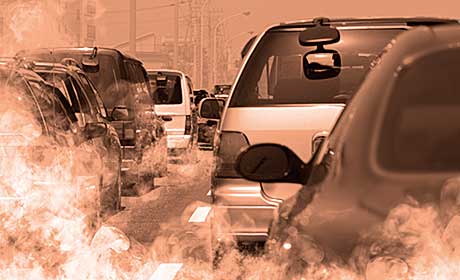
With many countries failing to meet air quality targets and large numbers of premature deaths still resulting from air pollution, Jim Mills explains why 2013 will be a pivotal year.
[hr]
IN November 2011 Janez Potocnik, European Commissioner for the Environment, expressed his determination to make 2013 the ‘Year of Air’. He acknowledged that there has been substantial improvement in air quality in recent decades but in the light of the environmental/climate issues surrounding air quality and the large number of premature deaths resulting from air pollution, he said: “The challenge for all of us is to address the shortcomings of existing regulations in a decisive and co-ordinated way. This will require the goodwill of policy-makers at all levels – European, national, regional and local – as well as other stakeholders such as the automotive and oil industries.”
‘This will require the goodwill of policy makers at all levels’
The European Environment Agency’s 2011 report on air quality reflects improvements for a number of key parameters, with concentrations of sulphur dioxide and carbon monoxide falling by about half in the decade ending in 2009.  However, the report also shows that in 2008, levels of nitrogen oxide, ozone and particulate matter rose, fuelling concerns about over-all air quality, especially in urban areas.
However, the report also shows that in 2008, levels of nitrogen oxide, ozone and particulate matter rose, fuelling concerns about over-all air quality, especially in urban areas.
According to the Commission, some 500,000 people die prematurely in the EU 27, mainly due to exposure to high levels of fine particulate matter – ¬atmospheric microparticles or ‘dust’ of a diameter of less than 2.5 micrometres – which originates from residential heating, transport such as diesel cars and trucks, ships and planes, agriculture, industrial processes and power production.
Particulates
Particulate pollution continues to be a major problem, despite the considerable progress that has been made in the reduction of larger particulates such as PM10. This is due, in no small part, to the standard monitoring methodologies that have been adopted because particulates are generally monitored as the PM10 or PM2.5 fraction, whereas it is widely acknowledged that the finer particles (< 1 micron), are able to penetrate deeper into the lungs, and are responsible for the most severe health effects.
Black Carbon
A further problem associated with tiny particles is their ability to act as ‘sponges’ carrying small amounts of toxic species such as PAHs and Dioxins which are adsorbed on to black carbon particles and transported deep into the body. PM10 and PM2.5 monitoring measurements provide a total figure for everything with mass in the sample and thereby assume that all particles are of equal significance. In reality this is not the case because some of the particles are benign from a human health perspective or are not anthropogenic so are of less interest from an air quality management perspective.
It is fortunate that the fine particles (from the combustion of fossil fuels) that are of most interest are black carbon and can be measured with an Aethalometer, which employs an optical method to only measure those fine particles which are black. Importantly, an Aethalometer can provide a real-time readout of the mass concentration of ‘black’ or ‘elemental carbon aerosol particles in the air which means that live data can be used to manage road traffic, the main contributor of urban black carbon. However, while the importance of black carbon is becoming widely acknowledged, air quality monitoring standards need to be adapted so that its monitoring is included in all national ambient monitoring stations.
A further consideration with black carbon is its role in climate change because, after carbon dioxide, it is believed to be the second largest contributor to current global warming. It increases global warming by absorbing sunlight, darkening snow and influencing the formation of clouds. Its effects are most noticeable at the poles, on glaciers and in mountainous regions, all of which are exhibiting the greatest effects of climate change.
Black carbon stays in the atmosphere for a relatively short period of time, from days to weeks, before falling to ground as a result of dry deposition or precipitation. This is an important consideration in global strategy to combat climate change because CO2 stays in the atmosphere for many decades, so emissions reductions will take a long time to have an effect, whereas efforts to reduce black carbon could have a much faster beneficial impact on global warming.
In June 2011, a UN Environment Programme (UNEP) study estimated that ‘near-term’ global warming could be quickly reduced by 0.5 degrees Celsius by a reduction in black carbon emissions and that this would have an even greater benefit in the Arctic where it could reduce warming by 0.7 degrees.
Global action
The importance of short-lived pollutants was recognised by the eight richest industrialised nations which agreed to take emissions reduction measures for short-lived climate pollutants, including black carbon, methane, ground-level ozone and hydro fluorocarbons at the recent G8 meeting in Maryland, USA.
The Camp David Declaration of May 2012 included the following: ‘Recognising the impact of short-lived climate pollutants on near-term climate change, agricultural productivity, and human health, we support, as a means of promoting increased ambition and complementary to other CO2 and GHG emission reduction efforts, comprehensive actions to reduce these pollutants, which, according to UNEP and others, account for over 30% of near-term global warming as well as two million premature deaths a year. Therefore, we agree to join the Climate and Clean Air Coalition to Reduce Short-lived Climate Pollutants.’
UK air quality
In common with most of Europe, the air quality improvements of recent decades have stalled and the UK is failing to meet many domestic and European air quality targets. The main parameters of concern are nitrogen oxides (from vehicles and electricity generation), ozone (formed by a reaction between nitrogen oxides and organic gases) and particulates (from combustion sources).
In 1952 over 4,000 Londoners – above the ‘normal’ mortality rate – were believed to have died as a result of the Great Smog and this led to the introduction of the Clean Air Act of 1956. However, in 1992, the Department of Health set up a committee on the medical effects of air pollutants which concluded that up to 24,000 deaths were still being ‘brought forward’ in the UK in 1995/1996 due to the effects of air pollution.
More recently, the UK Parliament’s Environment Audit Committee published a report which highlighted the UK’s poor performance on air quality. The subject has become a hotly-debated issue.
Public awareness
Local authorities monitor ambient air quality and publish data for the benefit of the public. However, as a result of public sector cutbacks environmental health professionals are focused on maintaining performance whilst implementing cost savings. Nevertheless, there are a number of opportunities for improvement; air quality needs to be higher on the political agenda and this can only be achieved if more people are aware of the problems, so we have to find ways to make it simpler for people to access easy to understand data. Happily, technology has advanced considerably and it will soon be possible to supplement existing monitoring networks with smaller low-cost ambient monitoring stations.
The main advantages of this technology, known as AQMesh, is that it can be positioned almost anywhere, improving spatial coverage and enhancing models. This will help ensure that readings are more representative of the air that people breathe. The AQMesh ‘pods’ are wireless, using battery power and GPRS communications to transmit data for the main air polluting gases to ‘the cloud’ where sophisticated data management will generate highly accurate readings as well as monitor hardware performance.
Traditional ambient monitoring stations have often been criticised because their physical location may limit their ability to provide representative data, so the ability to site low cost AQMesh pods in multiple locations, close to vehicles, passengers and pedestrians, will be a tremendous advantage.
[hr]
Jim Mills is a particulate monitoring specialist and managing director of Air Monitors.







